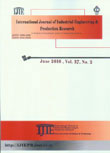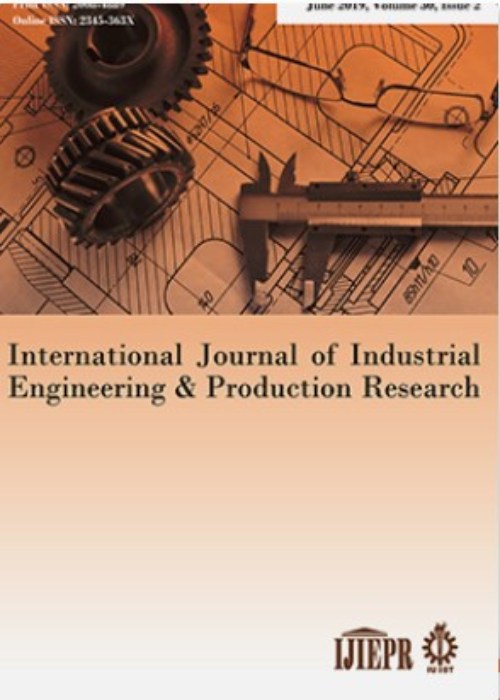فهرست مطالب

International Journal of Industrial Engineering and Productional Research
Volume:27 Issue: 4, Dec 2016
- تاریخ انتشار: 1395/10/10
- تعداد عناوین: 8
-
-
Pages 309-320Hubs are critical elements of transportation networks. Location of hubs and allocation of demands to them are of high importance in the network design. The most important purpose of these models is to minimize the cost, but path reliability is also another important factor which can influence the location of hubs. In this paper, we propose a P-center hub location model with full interconnection among hubs while there are different paths between origins and destinations. The purpose of the model is to determine the reliable path with lower cost. Unlike the prior studies, the number of hubs in the path is not limited to two hubs. The presented model in this paper is bi-objective and includes cost and reliability to determine the best locations for hubs, allocation of the demands to hubs and the best path. In order to illustrate our model, a numerical example is presented and solved using the Cuckoo Optimization Algorithm.Keywords: Hub location, Allocation, Reliable Path, Fully Interconnection, COA
-
Pages 321-335The locomotive assignment and the freight train scheduling are important problems in railway transportation. Freight cars are coupled to form a freight rake. The freight rake becomes a train when a locomotive is coupled to it. The locomotive assignment problem assigns locomotives to a set of freight rakes in a way that, with minimum locomotive deadheading time, rake coupling delay and locomotive coupling delay all freight rakes are hauled to their destinations. Scheduling freight trains consists of sequencing and ordering freight trains during the non-usage time between passenger trains but with no interference and with minimum delay times. Solving these two problems simultaneously is of high importance and can be highly effective in decreasing costs for rail transportation. In this paper, we aim to minimize the operational costs for the locomotive assignment and the freight train scheduling by solving these two problems concurrently. To meet this objective, an efficient and effective algorithm based on the ant colony system is proposed. To evaluate the performance of the proposed solution method, twenty-five test problems, which are based on the conditions of Iran Railways, are solved and the computational results are reported.Keywords: Management, Scheduling, planning, Railway systems
-
Pages 337-351This study aims to select optimal maintenance strategy for components of an electric motor of the National Iranian Oil Refining and Distribution Company. In this regard, a method based on revised multi choice goal programming and analytic hierarchy process (AHP) is presented. Since improving the equipment reliability is an important issue, reliability centered maintenance (RCM) strategies are introduced in this paper. Furthermore, on one hand, we know that maintenance cost consists of a considerable percentage of production cost; on the other hand, the risk of equipment failure is a main factor on personnels safety. Consequently, the cost and risk factors are selected as important criteria of maintenance strategies.Keywords: Revised Multi Choice Goal Programming, AHP, Maintenance Strategy Selection, Reliability Centered Maintenance (RCM)
-
Pages 353-371Flexible and dynamic supply chain network design problem has been studied by many researchers during past years. Since integration of short-term and long-term decisions in strategic planning leads to more reliable plans, in this paper a multi-objective model for a sustainable closed-loop supply chain network design problem is proposed. The planning horizon of this model contains multiple strategic periods so that the structure of supply chain can be changed dynamically during the planning horizon. Furthermore, in order to have an integrated design, several short-term decisions are considered besides strategic network design decision. One of these short-term decisions is determining selling price and buying price in the forward and reverse logistics of supply chain, respectively. Finally, an augmented e-constraint method is used to transform the problem to a single-objective model and an imperialist competitive algorithm is presented to solve large scale problems. The results analysis indicates the efficiency of the proposed model for the integrated and dynamic supply chain network design problem.Keywords: Supply Chain Network Design, Sustainability, Long-term, Short-term Decisions, e-constraint Method, Imperialist Competitive Algorithm
-
Pages 373-385This paper presents a bi-objective capacitated hub arc location problem with single assignment for designing a metro network with an elastic demand. In the literature, it is widely supposed that the network created with the hub nodes is complete. In this paper, this assumption is relaxed. Moreover, in most hub location problems, the demand is assumed to be static and independent of the location of hubs. However, in real life problems, especially for locating a metro hub, the demand is dependent on the utility that is proposed by each hub. By considering the elasticity of demand, the complexity of solving the problem increases. The presented model also has the ability to compute the number of trains between each pair of two hubs. The objectives of this model are to maximize the benefits of transportation and establishing the hub facilities while minimizing the total transportation time. Furthermore, the bi-objective model is converted into a single objective one by the TH method. The significance of applicability of the developed model is demonstrated by a number of numerical experiments and some sensitivity analyses on the data inspired by the Qom monorail project. Finally, the conclusion is provided.Keywords: Urban transportation, Capacitated hub arc location, Elastic demand, Incomplete hub network, Multi-objective programming
-
Pages 387-414Abstract Firms no longer compete as autonomous entities and prefer to joinin a supply chain alliance to take advantage of highly competitive business situation. Supply chain coordination has a greatimpact on Firmsstrategic partnering and success in competitive business environment. In this paper, we propose a system dynamics simulation model for strategic partner selection in supply chain. Our model addresses a supply chain including suppliers and retailers. It presents an approach to simulateeach suppliers (retailers) tendency to select downstream (upstream) partner selection and the impact of their policies in the whole supply chain.Keywords: Supply chain coordination, strategic partnering, upstream, downstream partner selection, information sharing, system dynamics
-
Pages 415-424Empirical studies show that there is stronger dependency between large losses than large profit in financial market, which undermine the performance of using symmetric distribution for modeling these asymmetric. That is why the assuming normal joint distribution of returns is not suitable because of considering the linier dependence, and can be lead to inappropriate estimate of VaR. Copula theory is basic tool for multivariate modeling, which is defined by using marginal and dependencies between variables joint distribution function. In addition, Copulas are able to explain and describe of complex multiple dependencies structures such as non-linear dependence. Therefore, in this study, by combining symmetric and asymmetric GARCH model for modeling the marginal distribution of variables and Copula functions for modeling financial data and also use of DCC model to determine the dynamic correlation structure between assets, try to estimate the Value at Risk of investment portfolio consists of five active index In Tehran Stock Exchange. The results demonstrate excellence of GJR-GARCH(1,1) with the distribution of t-student for marginal distribution. t-Copula model, estimates the Value at Risk model less than the Gaussian Copula in all cases.Keywords: Value at Risk, Copula theory, Investment portfolio, DCC model
-
A ROBUST OPTIMIZATION MODEL FOR BLOOD SUPPLY CHAIN NETWORK DESIGNPages 425-444The eternal need for human's blood as a critical commodity makes the healthcare systems attempt to provide efficient blood supply chains (BSCs) by which the requirements are satisfied at the maximum level. To have an efficient supply of blood, an appropriate planning for blood supply chain is a challenge which requires more attention. In this paper, we address a mixed integer linear programming model for blood supply chain network design (BSCND) with the need for making both strategic and tactical decisions throughout a multiple planning periods. A robust programming approach is devised to deal with inherent randomness in parameters data of the model. To illustrate the usefulness of the model as well as its solution approach, it is tested into a set of numerical examples, and the sensitivity analyses are conducted. Finally, we employ two criteria: the mean and standard deviation of constraint violations under a number of random realizations to evaluate the performance of both the proposed robust and deterministic models. The results imply the domination of robust approach over the deterministic one.Keywords: Blood supply chain, Location-allocation, Robust, Healthcare


